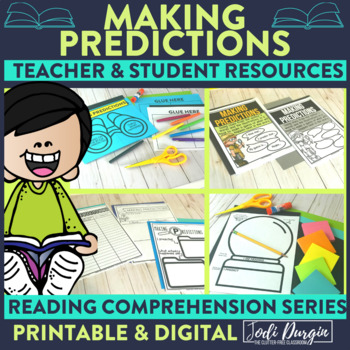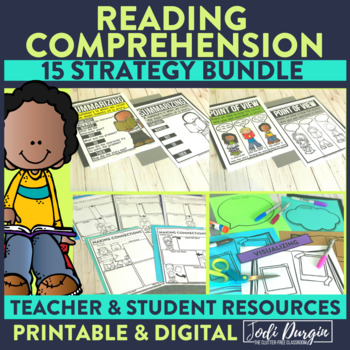Making predictions is an important reading comprehension strategy for elementary students to become proficient in. Good readers use their prior knowledge and information in the text to make predictions about what is going to happen next in the story. It helps readers better understand and enjoy stories they read and listen to. Learn all about how to teach making predictions below!
What is Making Predictions?
Making predictions is an important reading comprehension strategy to teach. Basically, a prediction is a statement that demonstrates what one believes will happen based on context clues. A reader will make a prediction about a text by using information to make guesses about the story or guesses about what might happen next. Typically, teachers ask students what they think a book will be about based on the title and cover, or what they think might happen next after reading part of a story.
Students use prior knowledge to make predictions and as a result they are connecting what they already know about a topic to the new and unfamiliar text. A skilled reader is always trying to guess or consider what a book is about before reading or what will happen next while they are reading.
When teaching students about this reading comprehension strategy, it is important for them to evaluate their predictions. They must consider if their prediction was accurate or not. This will help students to monitor their own understanding of a story. If students’ predictions were inaccurate it is important to have them discuss what actually happened in the story compared to their prediction.
Why Is Predicting an Important Comprehension Strategy?
Making predictions before and during reading is an important part of building comprehension. Students use this strategy as a way to connect their prior knowledge to the new information in a book. This helps them to gain meaning about the new topic as they read and in doing so they have a deeper understanding of the text. This strategy also helps students to begin anticipating what is going to happen next as they read.
When students make predictions, they have a purpose for their reading. Students are excited to see if their predictions come true therefore they are more engaged in the story. This is a way for them to monitor their understanding of the story. Oftentimes students are excited to finish a story if they are monitoring their predictions as they read.
As students start using this strategy they will begin looking closely at details within the story and using them to make their predictions. By evaluating their predictions, students will get a better idea of how well they were able to comprehend the book overall. As a result, it’s so important to teach making predictions.
Teaching Standards for Making Predictions
Standards for this reading comprehension topic include…
CCSS
- RL.1.1 – Ask and answer questions about key details in a text.
- RL.2.1 – Ask and answer such questions as who, what, where, when, why, and how to demonstrate understanding of key details in a text.
- RL.3.1 – Ask and answer questions to demonstrate understanding of a text, referring explicitly to the text as the basis for the answers.
- RL.4.1 – Refer to details and examples in a text when explaining what the text says explicitly and when drawing inferences from the text.
- RL.5.1 – Quote accurately from a text when explaining what the text says explicitly and when drawing inferences from the text.
TEKS
- Grade 1
- ELA.1.6.B – The student is expected to generate questions about text before, during, and after reading to deepen understanding and gain information with adult assistance.
- ELA.1.6.C – The student is expected to make and correct or confirm predictions using text features, characteristics of genre, and structures with adult assistance.
- ELA.1.7.C – The student is expected to use text evidence to support an appropriate response.
- Grade 2
- ELA.2.6.B – The student is expected to generate questions about text before, during, and after reading to deepen understanding and gain information.
- ELA.2.6.C – The student is expected to make and correct or confirm predictions using text features, characteristics of genre, and structures.
- ELA.2.7.C – The student is expected to use text evidence to support an appropriate response.
- Grade 3
- ELA.3.6.B – The student is expected to generate questions about text before, during, and after reading to deepen understanding and gain information.
- ELA.3.6.C – The student is expected to make and correct or confirm predictions using text features, characteristics of genre, and structures.
- ELA.3.7.C – The student is expected to use text evidence to support an appropriate response.
- Grade 4
- ELA.4.6.B – The student is expected to generate questions about text before, during, and after reading to deepen understanding and gain information.
- ELA.4.6.C – The student is expected to make and correct or confirm predictions using text features, characteristics of genre, and structures.
- ELA.4.7.C – The student is expected to use text evidence to support an appropriate response.
- Grade 5
- ELA.5.6.B – The student is expected to generate questions about text before, during, and after reading to deepen understanding and gain information.
- ELA.5.6.C – The student is expected to make and correct or confirm predictions using text features, characteristics of genre, and structures.
- ELA.5.7.C – The student is expected to use text evidence to support an appropriate response.
3 Tips for Teaching Students to Make Predictions
Below are suggestions for when you teach your students about making predictions when reading.
1. Read Aloud Picture Books
Reading aloud picture books is a great way to model and practice this reading comprehension strategy. There are tons of great read alouds out there for teaching students to make predictions. Some high-quality examples include Tops and Bottoms, Amazing Grace, Stone Soup, Knuffle Bunny, and Miss Nelson is Missing.
2. Make Anchor Charts
Anchor charts are another great way to teach students about predicting. My making predictions resource includes an interactive anchor chart that successfully engages students in their learning and provides a visual learning experience for students to learn about making predictions.
3. Use Videos
The third on the list of tips for teaching students to make predictions is playing videos. This is another great visual learning opportunity for students to learn about what can feel like a very abstract idea. Below are some examples of videos that are great for teaching students how to make predictions.
- https://www.youtube.com/watch?v=giCz53W-DCQ
- https://jr.brainpop.com/readingandwriting/comprehension/makepredictions/
Making Predictions Resources
These printable and digital resources for teaching elementary students about making predictions make curriculum and lesson planning quick and easy. It includes teacher, parent, and student resources, so you’ll have everything you need to deliver meaningful research-based instruction rooted in current best practices.
What is Included
1. Teacher Resources
There are teacher notes about the strategy, teaching ideas, a planning page with question prompts, and list of mentor texts, so you have all of the information you need to plan a research and standards-based reading unit based on this reading comprehension strategy.
2. Parent Resources
There is a parent letter and a reading log with suggested question prompts so parents can confidently support and reinforce the strategy you are teaching with their children at home.
3. Instructional Resources
There are printables to create a large anchor chart and reference charts. Both save you lots of time searching for anchor chart ideas and supplemental teaching tools.
4. Student Resources
There are 3 printables and 2 activities for students that provide meaningful opportunities to practice and make sense of the reading strategy in a fun and engaging way
5. Digital Resources
There are digital versions of several of the resources so students can access them in school or at home using a technology device of their choice.
Why Teachers Love this Resource
- This collection of resources is versatile in that it can be used on it’s own or can be used to supplement any reading curriculum, so you will be able to continue to use these resources if your school adopts a new reading program or you switch school districts.
- This resource is part of a larger collection of reading strategy products, so you can provide a consistent instructional approach that your students quickly learn and understand the expectations and routines for. Learn more about this collection here!
- It’s a huge time saver! Instead of hunting for background information on a reading strategy and then searching for resources to teach the strategy, this comprehensive resource includes all of the information and resources you need to teach a whole unit on this reading strategy.
- The student activities are a lot of fun for students, which helps create a productive learning environment where students are engaged and learning!
- It includes resources that provide a great way to create a home-school connection with students’ families and support parents/guardians in continuing student learning at home.
In closing, we hope you found this post about how to teach making predictions helpful! If you did, then you may also be interested in this other post about elementary reading comprehension strategies.




